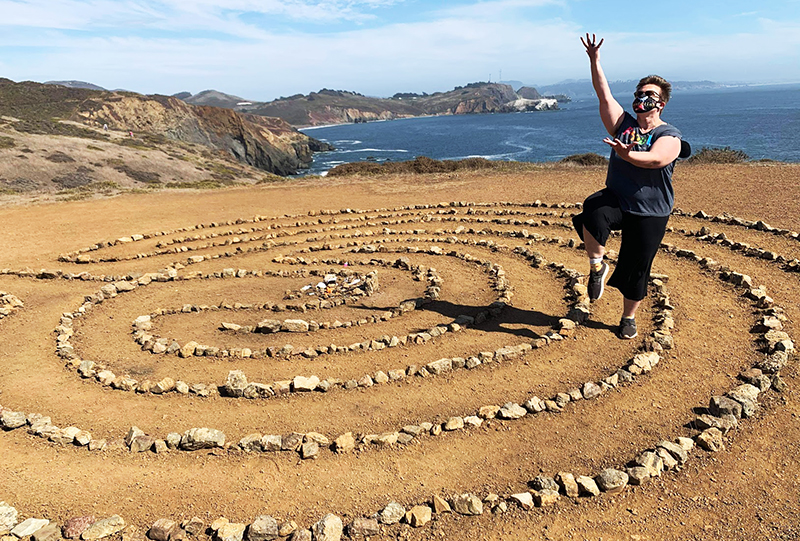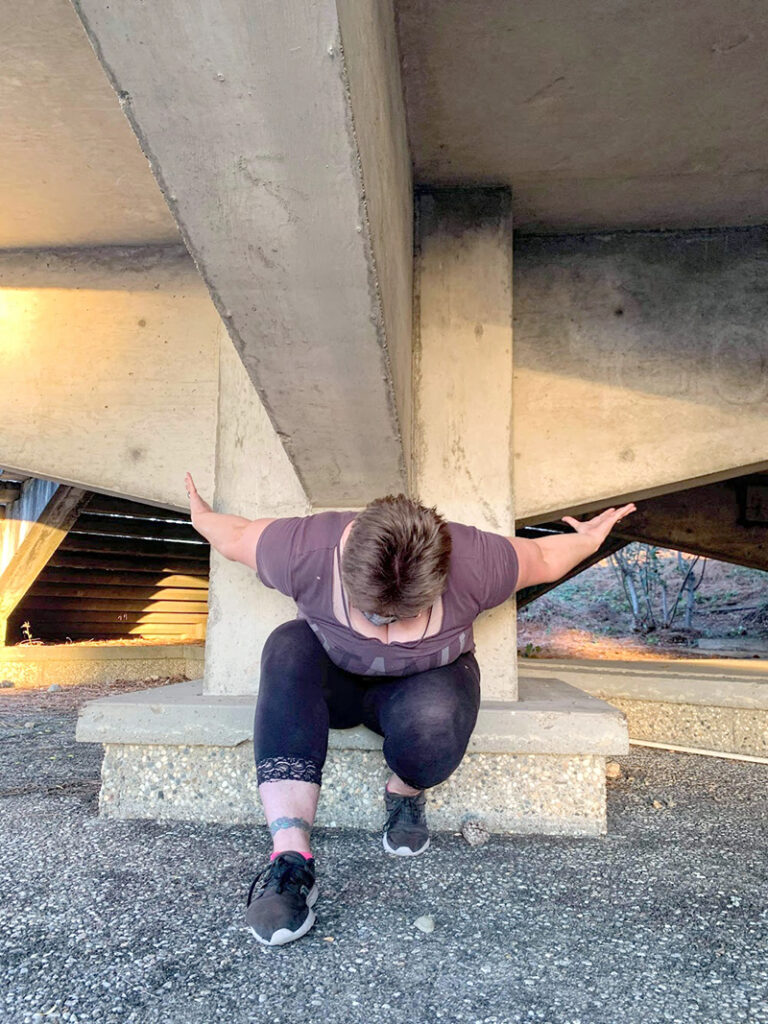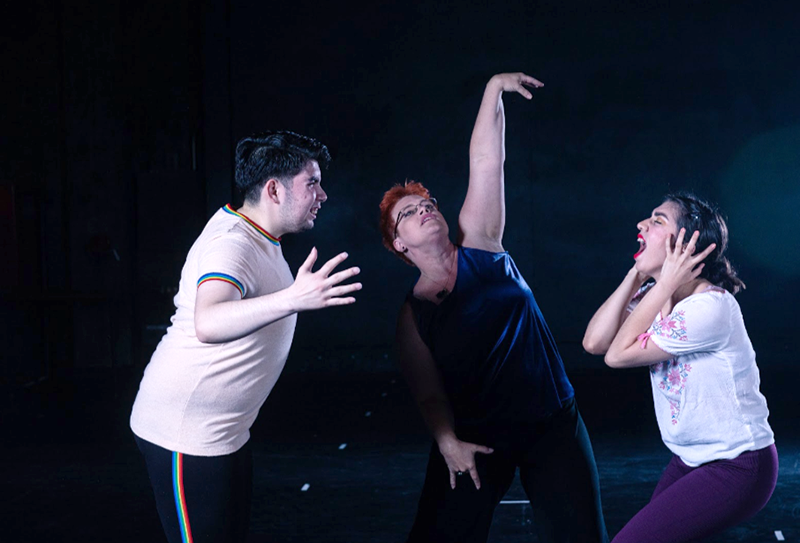Finding Their Voice, Forging Their Way
An Interview with Raven Malouf-Renning
BY EMMALY WIEDERHOLT
Raven Malouf-Renning is a Bay Area-based dancer and choreographer, the assistant director of the Inclusive Interdisciplinary Ensemble at Cal State East Bay, and one of the organizers of the Inclusive Performance Festival. Planned collectively through Dandelion Dancetheater and Cal State East Bay by a council of Queer, BIPOC, Autistic, Disabled, Jewish, Neurodivergent, Fat, Young, Elder, Outsider, and uncategorizable artists, the Inclusive Performance Festival is presenting virtual, in-person, and hybrid dance, music, theater, drag, ritual, educational events, participatory performances, discussions, workshops, ceremonies, and more this April/May 2021. Raven is helping organize Wandering in the Wilderness on April 16th, 17th, 23rd, and 24th. Here, they share their experience finding their own voice as a fat and non-binary performer, how spaces like the Inclusive Performance Festival reflect the perspectives of artists working outside the mainstream, and how they’d like to create awareness and support for artists whose bodies and minds have been affected as a result of contracting COVID-19.
To learn more, visit www.dandeliondancetheater.org/inclusive-performance-festival.
Note: Throughout April, Stance on Dance is featuring interviews with some of the organizers of the inaugural Inclusive Performance Festival, a wildly diverse group of artists, activists, free-thinkers, and creative rabble-rousers. Emmaly Wiederholt, editor of Stance on Dance and author of this interview, is one such rabble-rouser, and has enjoyed the opportunity to profile some of the other folks involved.

Pictured: Raven Malouf-Renning, Photo by Max Sovine
Image description: Raven is dancing among a circular labyrinth of small stones. They are to the right of the frame balancing on one leg with the other leg and both arms lifted. A scenic coastine is in the background.
~~
Can you share a little of your performance history so folks can get a sense of where you’re coming from?
I was enrolled in ballet lessons when I was four years old. This was in Lompoc, CA. There were two dance schools in the entire town. One was more interdisciplinary, and then I was at the very strict ballet school. When I was six, I was immersed in the Vaganova and Cecchetti pedagogies. It was an intense introduction to dance. I was an awkward clumsy kid, but I had visions of sugarplums in my head. I wanted to be a ballerina.
I am not the – square quotes – ideal dancer body. But I did the pointe shoes and everything until I was 18. Then I went to UC Santa Cruz and discovered modern dance. That’s where I met Eric Kupers of Dandelion Dancetheater and studied with Mel Wong and Silvia Martins. When I started college, I was still in that regimented pedagogy mindset. Mel came up to me after a rehearsal and said, “You really like to have things perfect. Bag it.” Over the course of the next year, I started to loosen up a bit.
My senior year, a theater guy by the name of Lee Breuer visited to do a text workshop. I was very shy at the time; my body was my instrument, and I was uncomfortable using my voice. He brought me up and gave me some text to work with, and I said I had nothing to say. He said, “Use that,” so next thing I knew I was screaming “I have nothing to say” in this sumo stance grabbing my hair, and it unleashed a beast. I choreographed my first text and spoken word piece and started to get noticed.
After graduation, I wound up with a company in Monterey called SpectorDance. It was a contemporary ballet/modern company. I was there for a couple years. Over that time, what I had been doing to maintain a “dancer” physique was catching up with me. My body deteriorated, and I ended up dropping out of the dance world. At the same time, I got divorced. My foundation was shaken. I ended up getting into the healing arts and massage. I started learning more about the body, getting to know the structures intimately and how a body fits together.
In 2004, I broke my leg. I had to re-learn how to walk and gained a substantial amount of weight. By then I wanted to get back to dance but knew it would take me forever to lose the weight. I wound up contacting Jessica Judd from Big Moves and found out I in fact did not have to lose weight. At the time, Big Moves had two companies: a modern company called Mass Movement and a hip hop group. I ended up dancing with Mass Movement and worked with some great choreographers.
The economy crashed and I needed to work in a spa fulltime, which took me out of dance. By the time I got back to Big Moves, they had folded the modern and hip hop companies into one that was jazz contemporary. It was then that I met Megan Briceno. She set some choreography on the Big Moves folks and recruited me for a project with Dandelion Dancetheater and the Inclusive Interdisciplinary Ensemble, both headed by Eric Kupers. I came to be part of a fat flash mob.
I said to Eric afterwards that I had been wanting to work with him for some time. He said, “Just come to rehearsals.” About a year or two later, we started this 49-hour project. We needed a huge committee to pull it off. Over that time, I started finding my feet as an assistant director. After that production, Eric said he needed to not hold everything by himself, and I said I’d been wanting to grow in directing an ensemble. I started off as a scheduling assistant, and I officially became the assistant director of the Inclusive Interdisciplinary Ensemble in 2019. I also joined the band Ultrasonic Current that Eric is a part of. I sang choir back in high school and college, and then learned to play the harmonium later. Eric said, “Bring your voice and your harmonium and we’ll see what happens.” We ended up collaborating on songs together and have a new album out.
The pandemic hit and we’ve had to adapt to working online. In 2020 I sought a residency for the first time and launched my solo work at SAFEhouse Arts. I wound up in a position where I helped formulate how we were going to do online showcases. I was not only making solo work, but also hosting these online showcases and now I’m involved in helping SAFEhouse adopt a co-op charter.

Pictured: Raven Malouf-Renning, Photo by Max Slovine
Image description: Raven is pictured crouched down under a concrete structure and posed as if they are supporting the structure on their back.
Speaking generally, how would you describe your work to someone unfamiliar with it?
The Interdisciplinary Inclusive Ensemble tends to be based in healing and reflecting on the world around us. We want people to bring their pain and we’ll find ways to transform and heal it. Often at rehearsals there will be this big confessional bit. From there, we’ll wind up doing a free-write. Then we’ll often generate gestures and movement, and we’ll take those movements and collage them in some form, as well as use text from the writing that stands out. We also do structured improv. We’re a mixed ability ensemble, so a lot of what we do is look for the essence of movement and find ways to translate that into any body.
As far as my solo practice, my work tends to put a spotlight on things we can’t talk about. The piece I created last spring was called Reach Out Don’t Touch, and it’s about being confined in four walls. I did a lot of furniture choreography for it.
I’m nonbinary, and this past summer the Trump administration revoked health protections for LGBTQ people. I created a piece in response called They, Not She where the text came first. When I’m doing a piece where the text comes first like that, I improvise with the text so my body can tell the story of what the words are not saying.
My piece Find Refuge Here grew out of a workshop I did in early August with Sara Shelton Mann and KJ Holmes. It was called Somatic Survival Strategies, so I started exploring what I gravitate to if I feel overloaded and need to scream or grieve. It ended up being a site-specific work that included a labyrinth and various scenes in my backyard and neighborhood. It was tied together by film. That’s one of the pieces I’m most proud of.
The piece I did just before winter break is called Acedia; it’s an ancient Greek word that speaks to that unnamable experience of being cooped up, both the fatigue and restlessness. My inner singer/songwriter explored the cycle of being bored, restless, uncertain, and afraid until I break out of it.
Until the Next Breath premieres April 18th at the SAFEhouse Arts showcase. It’s centered around my experience contracting COVID-19. I was very sick in December, and the piece is about going through the virus and healing.
Can you share what your involvement with the Inclusive Performance Festival has been?
I’m assistant directing Wandering in the Wilderness, a piece we’ve been developing for the past couple years. It’s about leaving the familiar behind when the next thing isn’t there yet. How do we navigate that unknown? A few weeks before we were going to premier the piece in spring 2020, the pandemic hit. The piece had to evolve and simplify. Now it’s about these enlightened beings from seven generations ahead coming back to the 21st century to talk about the disruption of 2020 and how everything fell apart.
I was more involved with the first chapter before I caught COVID, but since then I’ve been deeply involved in creating the second chapter. It will be all online following the first chapter and it’s about connecting with trees and using tree spirits as our anchors. It explores leaving the familiar behind and then getting stuck and realizing that the only way to move forward is to have a funeral for everything you once knew.
The onsite chapter will be performed first with limited seating on April 16th, 17th, 23rd, and 24th but will also be broadcast on Zoom. There will be a short intermission and then we will move into the online second chapter.
Why are spaces like the Inclusive Performance Festival important for people whose work falls outside of mainstream aesthetics or identities?
They are absolutely important because there’s so much happening in those liminal spaces. One of the hallmarks of art is that it holds up a mirror to society and becomes a catalyst for change and critical thinking. These spaces are especially important right now. A good 95 percent of people aren’t reflected in mainstream art. In these inclusive spaces, maybe they can find someone they can actually relate to.
What do you hope participants take away from the Inclusive Performance Festival?
I hope they’ll take away a broader insight into what art is and what’s possible, and that they’ll feel inspired to champion artists in their own communities. Or better yet, if art is something they want to do, that they can do it. For me, that would be the greatest gift is for people to get inspired to add to the body of work and the reflections of society.

Pictured (L-R): Richard Nguyen, Raven Malouf-Renning, Stephanie Camacho; Photo by Garvin Tso
Image description: Three dancers are onstage with a black backdrop. The dancers on the left and right are facing each other, the dancer on the left with arms to the side and the dancer on the right with hands over ears and mouth open. Raven is in the middle with one arm reaching upward and their hand flagged to the side.
What’s next for you in terms of your own work?
I envision starting panel discussions and focus groups centering artists who have survived COVID-19. I want to create a space for them to get their stories out and eventually evolve it into a workshop to make work together. I’m finding this is particularly important for artists who were in the mainstream pre-COVID and who are now in bodies and minds they don’t recognize. How can you find your voice in this new place?
I’m starting out with research on my own body. I’ve gone from pushing physical boundaries to researching how my sternum and ribs move. I got punched in the lungs pretty hard by COVID, so I’m figuring out how to have a rib cage and lungs again, and how the parts fit together. I’m taking myself through that process so I can invite others to facilitate that process for themselves. Eventually, I would love to create workshops where we travel to different universities, theater groups, and dance companies and help them find their way into this work.
~~
Read more about Raven at safehousearts.org/raven-malouf-renning and follow them on Instagram @corvidmelodies. Check out Ultrasonic Current’s new album at ultrasoniccurrent.hearnow.com.
To learn more about the Inclusive Performance Festival, visit www.dandeliondancetheater.org/inclusive-performance-festival.
